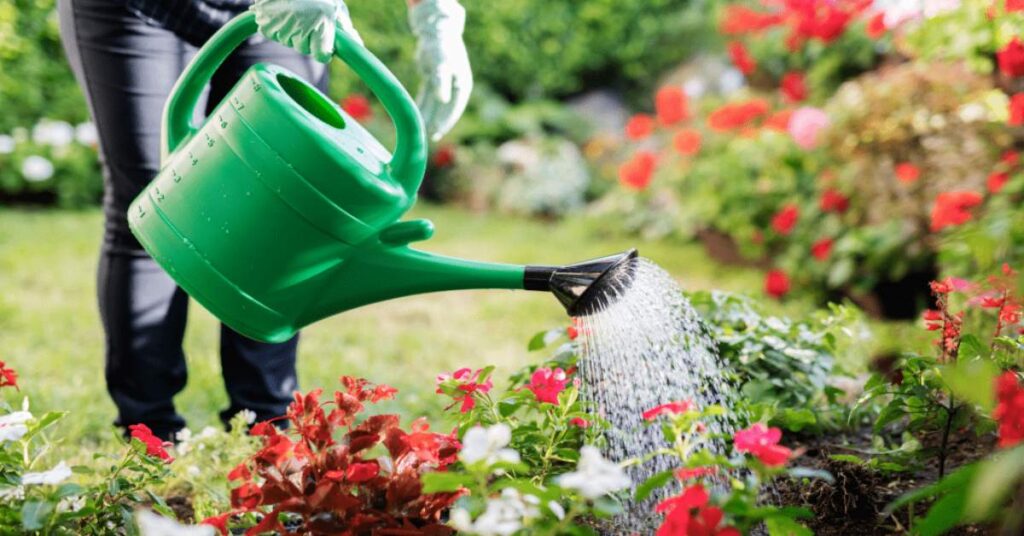Last updated on March 27th, 2024 at 10:32 pm
When was the last time you walked barefoot across your lawn and took in the beauty of the green grass beneath your feet? While a lush lawn certainly provides an inviting space for recreation or relaxation, typical lawn care practices are far from environmentally friendly. The average homeowner applies huge amounts of chemical fertilizers, pesticides, and herbicides to their grass each year without considering the impact these products have on local waterways and wildlife.
However, there is good news! By making some small adjustments to your routine, you can care for your lawn in a more sustainable way that protects the environment and potentially saves you money, too. In this post, we will share seven simple lawn care strategies you can implement this season to create an eco-friendly oasis in your backyard.
Table of Contents
1. Switch to natural alternatives
The easiest and most effective way to make your lawn more eco-friendly is by switching to natural alternatives for traditional chemical fertilizers, herbicides, and pesticides. These can be found at most garden centers or even made at home using household ingredients like vinegar or dish soap. Natural options are safer for the environment and your family and pets who may come into contact with your lawn.
- Compost: Composting your kitchen scraps reduces landfill waste and enriches your lawn’s soil with vital nutrients.
- Corn Gluten Meal: A natural byproduct of corn manufacturing, corn gluten meal can be used as an organic weed suppressant and fertilizer.
- Vinegar: A simple vinegar and water solution can be an effective, natural weed killer.
- Nematodes: These beneficial microscopic worms can naturally control pests in your lawn, like grubs and beetles.
2. Mow higher
Many homeowners make the common mistake of mowing their grass too short, which can leave it vulnerable to disease and pests. By setting your mower blade to a higher height, you encourage healthier root growth and help the soil retain moisture, reducing the need for watering.
- Mulching: Instead of bagging grass clippings, let them decompose on your lawn. They return nutrients to the soil and reduce the need for synthetic fertilizers.
- Grasscycling: This term refers to leaving grass clippings on the lawn after mowing. The clippings quickly decompose and return necessary nutrients back to the soil.
- Alternate Directions: Each time you mow, try to alternate the direction. This prevents the grass from leaning in the direction you mow and helps it stand tall for even cuts.
3. Aerate your lawn
Aeration is the process of perforating the soil to allow water, air, and nutrients to reach the grassroots more easily. This helps keep your lawn healthy and strong while also reducing the need for chemical fertilizers. Visit an aeration expert’s website to get more info on different techniques.
- Spike Aeration: This method uses a lawn spike aerator to poke holes into the ground. It’s a simple and cost-effective technique, but it’s less effective than core aeration for compacted lawns.
- Core Aeration: Core aeration removes plugs of soil from the lawn to create holes for air, water, and nutrients. It’s a more effective method for relieving soil compaction and is better suited for lawns that receive heavy foot traffic.
- Liquid Aeration: This is a newer method that involves the application of a liquid soil conditioner. The conditioner breaks down hard, compacted soil and promotes deeper root growth and better water absorption.
4. Choose drought-resistant grass
If you live in an area with frequent droughts or have limited access to water, consider choosing a drought-resistant grass variety for your lawn. These types of grass are specifically designed to thrive in dry conditions and require less watering.
- Bermuda Grass: Known for its exceptional heat tolerance and ability to withstand heavy use, Bermuda grass is a robust, low-maintenance option for those in warmer climates.
- Zoysia Grass: With its ability to withstand droughts and its versatility in various soil types, Zoysia is an excellent choice for many homeowners.
- Buffalo Grass: Native to the Great Plains, this grass type is adapted to semi-arid climates and requires little water.
5. Use rain barrels
Instead of using tap water to hydrate your lawn, consider investing in rain barrels that can collect and store rainwater for future use. This reduces your reliance on municipal water and helps prevent runoff and erosion.
- Placement: Strategically place your rain barrels under downspouts to capture the most rainwater runoff from your roof.
- Overflow: Ensure your barrel has an overflow valve or spout. This will direct excess water away from your home’s foundation.
- Cover: Always keep your rain barrel covered to prevent mosquitoes and other pests from breeding in the water.
6. Embrace natural lawn care techniques
Embracing natural lawn care techniques such as leaving grass clippings on the lawn, mulching leaves instead of raking them, and using compost instead of chemical fertilizers can greatly benefit your lawn and the environment. These practices help promote healthy soil and reduce waste in landfills.
- Grasscycling: Instead of bagging and disposing of grass clippings, leave them on your lawn after mowing. They will decompose and return essential nutrients to the soil, reducing the need for chemical fertilizers.
- Composting: Create a compost pile with organic waste such as leaves, vegetable scraps, and grass clippings. This rich, natural compost can be used as a soil conditioner to improve soil structure and nutrient content.
- Organic Fertilizers: Opt for organic fertilizers over synthetic ones if additional nutrients are needed. Organic fertilizers contain natural material and help improve soil structure over time.
7. Plant native species
When choosing plants for your lawn, opt for native species that are already adapted to your local climate and require less maintenance. Native plants also provide food and shelter for local wildlife, making your lawn a more eco-friendly oasis for both you and nature.
- Research: Before planting, research native plants that thrive well in your specific region. This will give you an idea of what plants will grow best in your lawn conditions.
- Planning: Arrange your plants according to their sunlight and watering needs. Also, consider the size of the plant at full maturity to ensure you’re providing enough space.
- Soil Preparation: Improve your soil by adding organic matter or compost before planting. This will provide your new plants with a rich, nutrient-dense environment to grow in.
Related Articles:
Is Buying a Condo a Good Choice for Young Families?
Self Storage Unit Maintenance Tips
In Conclusion
Implementing these eco-friendly practices into your lawn care routine can reduce water waste, prevent pollution, conserve resources, and create a beautiful and sustainable outdoor space. Taking steps towards making your lawn more eco-friendly not only benefits the environment but also saves you time and money in the long run. Let’s all do our part in protecting our planet by making our lawns a little greener.







